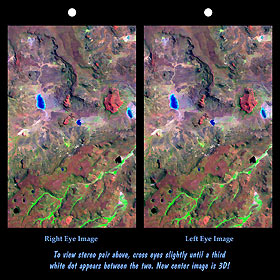
Save this image free of charge
in 800 pixels for layout use
(right click, Save as...)
|
|
Ref : V02062
Theme :
Looking at Earth - Plains - Plateaus - Valleys (487 images)
Title : Stereo Pair: Patagonia, Argentina
Caption :
This view of northern Patagonia, near El Cain, Argentina shows complexly eroded volcanic terrain, with basalt mesas, sinkholes, landslide debris, playas, and relatively few integrated drainage channels. Surrounding this site (but also extending far to the east) is a broad plateau capped by basalt, the Meseta de Somuncura. Here, near the western edge of the plateau, erosion has broken through the basalt cap in a variety of ways. On the mesas, water-filled sinkholes (lower left) are most likely the result of the collapse of old lava tubes. Along the edges of the mesas (several locations) the basalt seems to be sliding away from the plateau in a series of slices. Water erosion by overland flow is also evident, particularly in canyons where vegetation blankets the drainage channels (green patterns, bottom of image). However, overland water flow does not extend very far at any location. This entire site drains to local playas, some of which are seen here (blue). While the water can reach the playas and then evaporate, what becomes of the eroded rock debris? Wind might excavate some of the finer eroded debris, but the fate of much of the missing bedrock remains mysterious.This cross-eyed stereoscopic image pair was generated using topographic data from the Shuttle Radar Topography Mission, combined with an enhanced Landsat 7 satellite color image. The topography data are used to create two differing perspectives of a single image, one perspective for each eye. In doing so, each point in the image is shifted slightly, depending on its elevation. When stereoscopically merged, the result is a vertically exaggerated view of the Earth's surface in its full three dimensions.Landsat satellites have provided visible light and infrared images of the Earth continuously since 1972. SRTM topographic data match the 30-meter (99-foot) spatial resolution of most Landsat images and provide a valuable complement for studying the historic and growing Landsat data archive. Elevation data used in this image was acquired by the Shuttle Radar Topography Mission (SRTM) aboard the Space Shuttle Endeavour, launched on February 11, 2000. SRTM used the same radar instrument that comprised the Spaceborne Imaging Radar-C/X-Band Synthetic Aperture Radar (SIR-C/X-SAR) that flew twice on the Space Shuttle Endeavour in 1994. SRTM was designed to collect three-dimensional measurements of the Earth's surface. To collect the 3-D data, engineers added a 60-meter-long (200-foot) mast, installed additional C-band and X-band antennas, and improved tracking and navigation devices. The mission is a cooperative project between the National Aeronautics and Space Administration (NASA), the National Imagery and Mapping Agency (NIMA) of the U.S. Department of Defense (DoD), and the German and Italian space agencies. It is managed by NASA's Jet Propulsion Laboratory, Pasadena, CA, for NASA's Earth Science Enterprise, Washington, DC.Size: 23.9 kilometers (14.8 miles) x 15.2 kilometers (9.4 miles) Location: 42 deg. South lat., 68 deg. West lon.Orientation: North toward upper left Image Data: Landsat bands 1,4,7 in blue, green, red Date Acquired: February 19, 2000 (SRTM), January 22, 2000 (Landsat)
|
|

